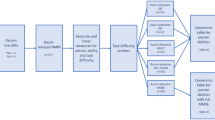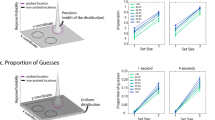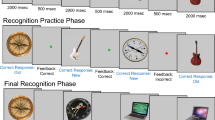Abstract
A SPECIFIC isolated and severe defect of memory, with preservation of other intellectual functions, including span of attention, may occur as the result of localized brain pathology. In amnesic patients the memory defect is so marked that performance on tests of recent memory declines sharply within a matter of minutes1.
This is a preview of subscription content, access via your institution
Access options
Subscribe to this journal
Receive 51 print issues and online access
$199.00 per year
only $3.90 per issue
Buy this article
- Purchase on Springer Link
- Instant access to full article PDF
Prices may be subject to local taxes which are calculated during checkout
Similar content being viewed by others
References
Talland, G. A., Deranged Memory (Academic Press, 1965).
Milner, B., in Analysis of Behavioural Change (edit. by Weiskrantz, L.) (Harper and Row, 1968, in the press).
Dimsdale, H., Logue, V., and Piercy, M., Neuropsychologia, 1, 287 (1964).
Gollin, E. S., Percept. Mot. Skills, 11, 289 (1960).
Warrington, E. K., and Weiskrantz, L., Neuropsychologia (1968, in the press).
Weiskrantz, L., in Amnesia (edit. by Whitty, C. W., and Zangwill, O. L.) (Butterworth, 1966).
Williams, M., J. Neurol. Neurosurg. Psychiat., 16, 14 (1953).
Author information
Authors and Affiliations
Rights and permissions
About this article
Cite this article
WARRINGTON, E., WEISKRANTZ, L. New Method of Testing Long-term Retention with Special Reference to Amnesic Patients. Nature 217, 972–974 (1968). https://doi.org/10.1038/217972a0
Received:
Revised:
Issue Date:
DOI: https://doi.org/10.1038/217972a0
This article is cited by
-
Newly-formed emotional memories guide selective attention processes: Evidence from event-related potentials
Scientific Reports (2016)
-
Anterograde Episodic Memory in Korsakoff Syndrome
Neuropsychology Review (2012)
-
Implicit Memory in Korsakoff’s Syndrome: A Review of Procedural Learning and Priming Studies
Neuropsychology Review (2012)
-
A model for memory systems based on processing modes rather than consciousness
Nature Reviews Neuroscience (2010)
-
Analysis of the studies of the perception of fragmented images: global description and perception using local features
Neuroscience and Behavioral Physiology (2009)
Comments
By submitting a comment you agree to abide by our Terms and Community Guidelines. If you find something abusive or that does not comply with our terms or guidelines please flag it as inappropriate.



